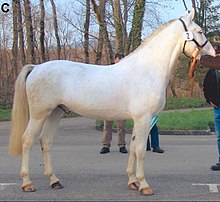Dominant white horse
A dominantly white horse gets its completely white color through leucism , which means that the melanocytes, the cells that produce the pigments, have not reached the skin due to a mutation.
Appearance
A horse of dominant white color has snow-white fur and pink skin all over its body from birth. Some colored hair can only appear on the ears, in the mane or in the tail. The horse's eyes are brown, sometimes blue.
genetics
It was assumed that there is a white gene (W) that possesses a dominant inheritance. In the meantime, however, it has been found that several different mutations of the KIT locus lead to a dominant white color. So it is a form of leucism .
Some of these W genes, in their homozygous expression (WW), are fatal in early embryonic development. That is, they lead to a miscarriage during this time. In the case of other W genes, it is not known what influence the homozygous expression has.
In rare cases it happens that the gene W is not fully expressed in heterozygous form, but rather creates a spotted check that looks similar to a Sabino checkered.
Heterozygous dominant white horses are not known to have any health problems.
The same gene has mutated in the Tobiano , the color changer and the Sabino check. The genes to (no Tobiano check), w (no dominant white color), rn (no prickly hair) and sbn (no Sabino check) are therefore each the same gene - namely the normal color without white spots - while To (Tobiano check) , Sbn1 (the one known so far for Sabino check), Rn (prickly hair) and W (dominant white color) are different alleles of the same gene. If a horse breeds one of these four genes (that is, has the gene twice), it cannot have either of the other two genes. If it is not inherited, it can have at most two of these predispositions. Close by on the same chromosome is the horse's extension locus , so that the chestnut color is often inherited over several generations together with one of these genes.
W genes of different races
Freiberger
In Freiberg horses there is a mutation of the KIT locus that is caused by a nonsense mutation in exon 15 of the gene, which means that the KIT protein is only partially synthesized because of a premature stop codon. In heterozygous horses that have one mutated and one healthy allele of the gene, the mutated KIT protein is only about half as common as the healthy one. This is due to mechanisms that serve to break down damaged proteins or prevent their synthesis. This mutation, if homozygous, is likely to be fatal in the early embryonic stage.
The mutation can be traced back to the white mare Cigale, who was born in 1957.
Arabs
Three almost white Arabs had a different nonsense mutation in exon 4 of the KIT locus. This mutation, if homozygous, is likely to be fatal in the early embryonic stage.
Camarillo White Horse
Six horses of the Camarillo White Horse breed had a missense mutation in exon 12 of the KIT locus. It goes back to the founding stallion of the Sultan breed, who was born in 1912.
English blood
Five white English thoroughbreds had another missense mutation in exon 13 of the KIT locus. According to thoroughbred pedigrees, there are several families in which a dominant-white mutation has occurred independently.
More genes
In 2009, seven further genes for dominant white color were discovered in the KIT locus in English thoroughbreds, Icelandic ponies, Holstein horses, quarter horses and southern German draft horses.
Possible confusion
- Cremello, Perlino, Smoky Cream : Horses that have been lightened twice by the Cream gene differ from the Dominant White Horse by their blue eyes. The fur has a light golden or silver sheen and is not snow-white.
- Mold : has dark skin
- Maximum piebald : Different eye color depending on the piebald gene, otherwise like Dominant White Horse
See also
Web links
swell
- ↑ Veterinary genetics laboratory: Dominant white
- ^ The Myth of True-Breeding White Horses
- ^ A b c D. Douglas Householder: The Genetics of Equine Coat Color. Texas A&M University Department of Animal Science Equine Sciences Program, publication HRG-003 (undated) '( Memento of March 8, 2008 in the Internet Archive )
- ↑ a b C. Mau, PA Poncet, B. Bucher, G. Stranzinger, S. Rieder: Genetic mapping of dominant white (W), a homozygous lethal condition in the horse (Equus caballus). In: Journal of Animal Breeding and Genetics. 121 (6), Volume 121, Issue 6, 2004, pp. 374-383. doi: 10.1111 / j.1439-0388.2004.00481.x
- ↑ a b c d e f g h i Bianca Haase, Samantha A. Brooks, Angela Schlumbaum, Pedro J. Azor, Ernest Bailey, Ferial Alaeddine, Meike Mevissen, Dominik Burger, Pierre-Andre ́ Poncet, Stefan Rieder, Tosso Leeb: Allelic Heterogeneity at the Equine KIT Locus in Dominant White (W) Horses. In: PLoS Genet . 3 (11), p. E195. doi: 10.1371 / journal.pgen.0030195
- ↑ B. Haase, SA Brooks, T. Tozaki, D. Burger, PA Poncet, S. Rieder, T. Hasegawa, C. Penedo, T. Leeb: Seven novel KIT mutations in horses with white coat color phenotypes. In: Anim Genet. 2009 May 6. PMID 19456317





